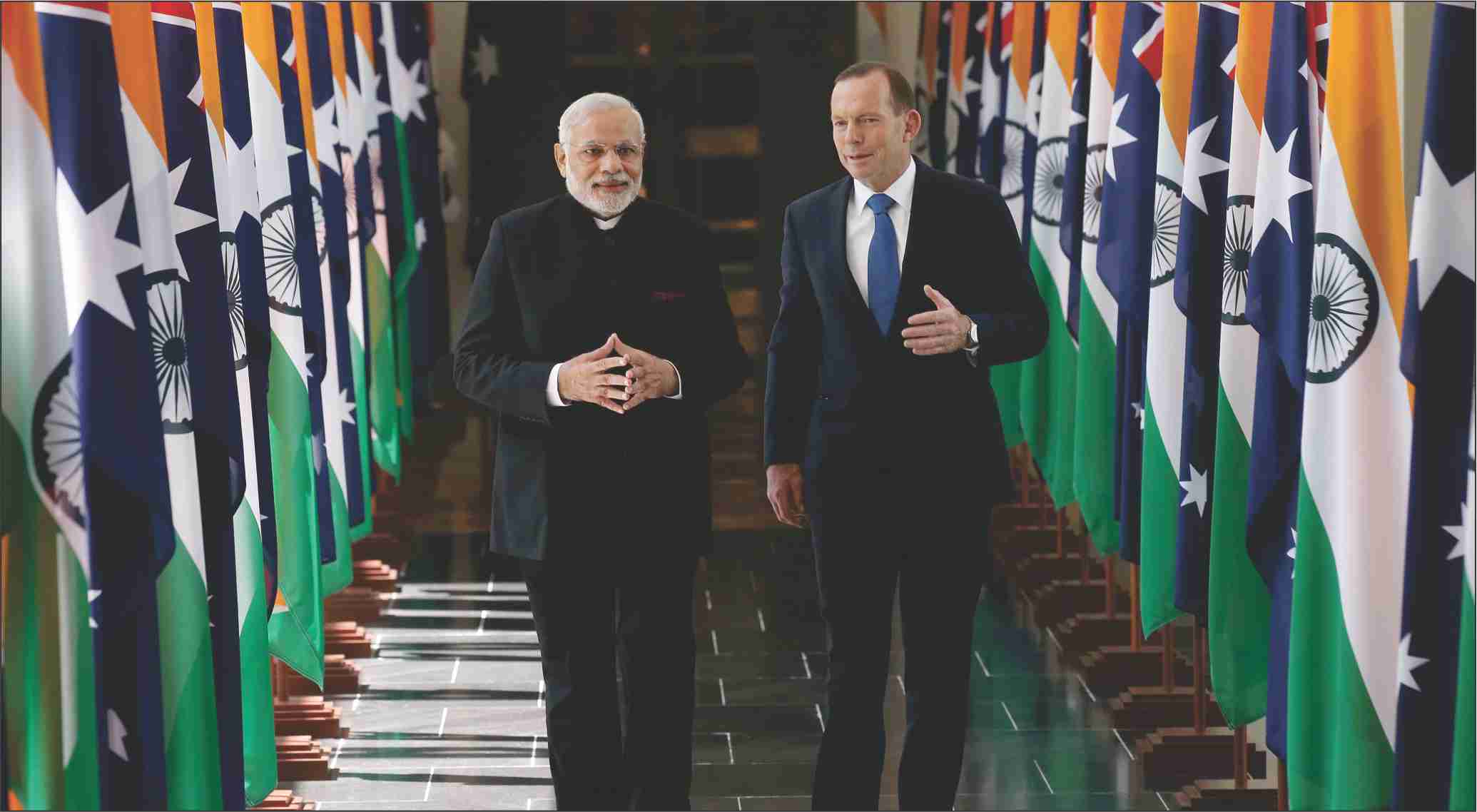India and Australia in Indian Ocean
The year 2014 has seen the rise of Narendra Modi on world geo-political scene and his getting closer to the allies of USA, which will culminate in the visit of President Barack Obama next year as the Chief Guest for the Indian Republic Day on 26th January.
After a landmark visit to Japan in early September, Prime Minister Modi invited the Australian Prime Minister Tony Abbott a fortnight later, which was followed by Mr Modi availing the opportunity to attend G-20 summit in mid-November to convert his visit into a bilateral one. This was unprecedented in India-Australia bilateral relations , as Australia was once very vocal against India’s nuclear posture. There seems to be a pattern in India forging closer strategic relations with US allies.
The repeat of grand public receptions, as seen in US, in Australian cities also, reaffirmed Modi’s profile as rising star on world scene. It was natural that the Australian leadership recognized Modi’s prowess as the leader of a rising India and reiterated their commitment to forge strong bilateral ties not only in economic arena but also in strategic and defence field. During the September visit of Prime Minister Abbott to New Delhi, the two Prime Ministers had committed to strengthening the defence and security partnership.
Nuclear energy
Cooperation in nuclear field is another significant facet of bilateral strategic partnership. Commenting on this Prime Minister Modi himself reacted, “The signing of the civil nuclear cooperation agreement is a historic milestone in our relationship. It is a reflection of a new level of mutual trust and confidence in our relationship and will open a new chapter in our bilateral cooperation. It will support India’s efforts to fuel its growth with clean energy and minimize the carbon footprint of its growth.”
Experts unanimously agree that cooperation in civil nuclear sector will promote deeper strategic partnerships. Only because of the convergence of interests on nuclear cooperation issues Australia has decided to support India’s case for full membership in four export control regimes of the world i.e. the Nuclear Supplier Group, the Wassenar Arrangement, the Australia Group and the Missile Technology control Regime.
The membership to these restricted regimes will help India obtain sensitive dual use nuclear and defence technologies and systems, which will help India increase its technological strength in nuclear and defence arena and promote India as technological power.
This will help India match the technological competence of China, which has therefore been resisting India’s bid to gain entry to these Clubs. Hence, Australia’s support to India will be extremely critical as Australia was the one which vehemently opposed India’s nuclear tests in May, 1998 and as a consequence decided to withdraw its military attaché from New Delhi. Australia had also vehemently opposed the US diplomatic efforts to enable the Nuclear Suppliers Group to lift all sanctions on nuclear exports. However, the Defence Attaches has now been posted back in New Delhi and Melbourne and the two countries are extensively discussing the revival of defence relations on a much larger scale.
Interestingly Australia had drawn cold feet when its proposal to develop a quadrilateral alliance with Japan, US and India was strongly rebuffed by China in 2007. India , US and Japan had then conducted joint Malabar exercises off the Japanese coast and Australia was represented by its defence official as observer. Early in 2007 Australia had participated in a five nation joint maritime exercises called Malabar in the Bay of Bengal which included India, Australia, US, Japan and Singapore. All the four partners are still seen as belonging to Western Alliance , though individually all the four had then good bilateral relations with China , but lurking fear of rise of China occasionally brings all the four western partners together.
In spite of national commitment in Australia, there are still some legislative procedures to be completed, before the nuclear cooperation deal begins its execution at the ground level. The administrative arrangements are yet to be completed and may take few months more.
India is mainly seeking to obtain Uranium nuclear fuel from Australia, which is a repository of world’s Uranium. Though the demands for Uranium for Indian nuclear power plants can be fulfilled from spate of other nuclear fuel producing countries like Kazakhstan and Namibia, with whom India has also entered nuclear cooperation agreements.
But India is eyeing the Australian nuclear fuel mainly because of easy availability. Significantly Australia has agreed to Indian proposal to mine Uranium from Australian mines, which no other country would normally permit. India is deficient in Uranium and due to restricted supply of Uranium Indian nuclear power plants have been facing critical situation due to fuel shortages and hence were running on less capacity.
Now with the signing of nuclear deals with many developed and developing countries the problem of fuel shortage has been overcome. However, India promoting nuclear cooperation with Australia is not solely for buying nuclear fuel. India wants to mine Uranium from Australia and Australia has agreed to India’s desire and have already begun negotiations with Indian nuclear mining company, the Uranium Corporation of India ltd and some private firms, who have never done nuclear commerce have also joined the fray.
Maritime cooperation
Besides the nuclear cooperation, cooperation in maritime arena would draw world’s attention. In view of China’s grand designs in Indian Ocean the coming together of India and Australia to jointly safeguard their maritime interests has special significance in strategic world. This has resulted in a decision to hold inaugural bilateral maritime exercise to be held in early 2015 and both have also decided to work on new initiatives to further strengthen defence cooperation in defence science and industry. After this joint reaffirmation, both reiterated their commitment, “India and Australia must not only work together with a sense of priority to promote peace and prosperity in Asia, Pacific and Indian Ocean region but also take on the responsibility of bringing together all other countries in the region.
Significantly, to promote maritime security in Indian Ocean, of which both the countries are two big littoral powers, both India and Australia are already working together in the Indian Ocean Rim Association. India and Australia are also working together in Indian Ocean Naval Symposium, a group of members comprising the littoral states of Indian Ocean. India thus has constructed and promoted two major maritime constructs, on the strength of which the two countries can build a solid foundation of defence and security cooperation.
This is why Prime Minister Modi made an unequivocal statement, “our two countries can contribute to a variety of objectives in the Indian Ocean region, including in humanitarian assistance and disaster relief. We will also increase security cooperation to counter terrorism, cyber threats and other security challenges.”
Situated on the two distant shores of Indian Ocean, India and Australia are thus working on a joint plan and program to safeguard their common interests, which will require deeper security and defence cooperation. This coming together of two Indian Ocean giants will cause concern in non-Indian Ocean powers who want to set up bases in Indian Ocean.




